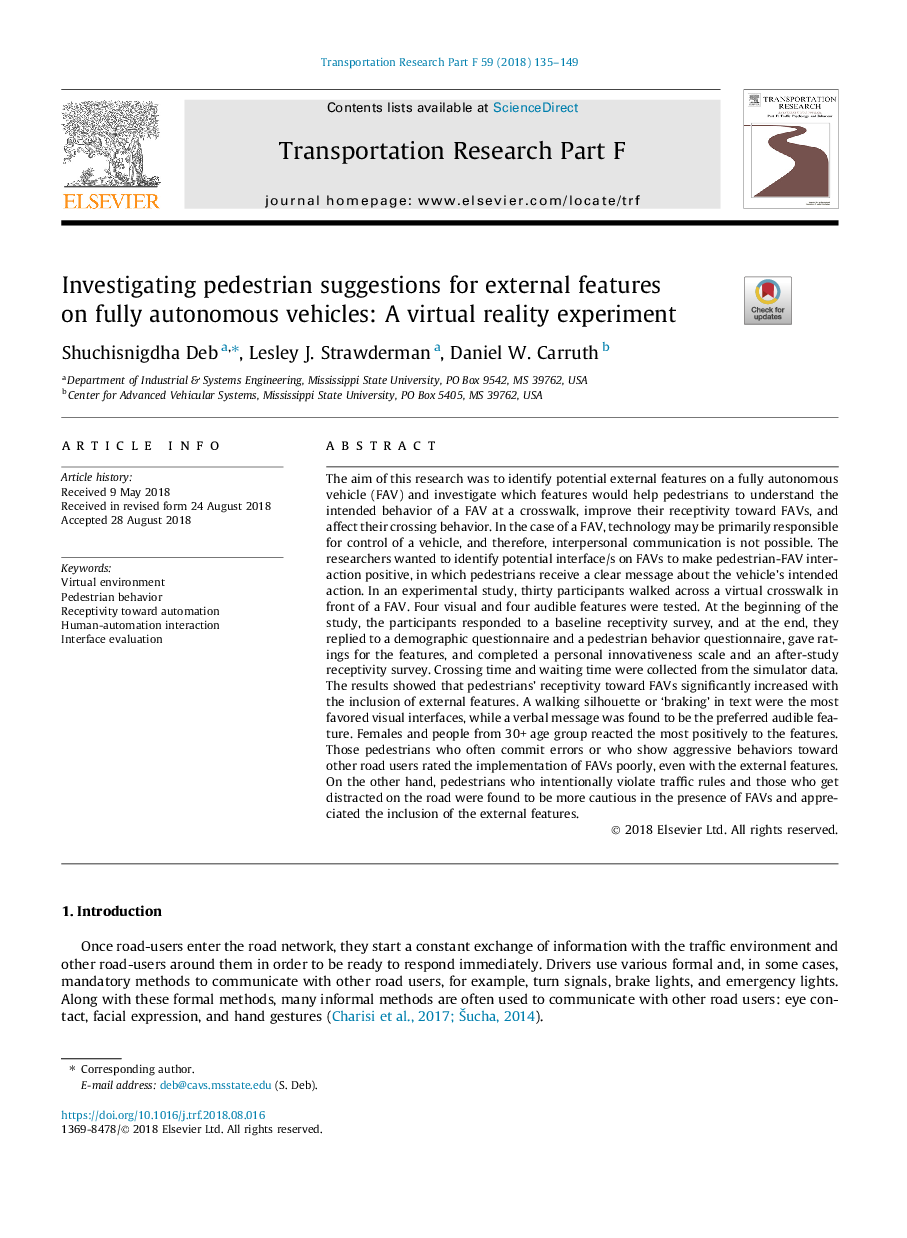| کد مقاله | کد نشریه | سال انتشار | مقاله انگلیسی | نسخه تمام متن |
|---|---|---|---|---|
| 10134404 | 1645613 | 2018 | 15 صفحه PDF | دانلود رایگان |
عنوان انگلیسی مقاله ISI
Investigating pedestrian suggestions for external features on fully autonomous vehicles: A virtual reality experiment
ترجمه فارسی عنوان
بررسی پیشنهادات عابران پیاده برای ویژگی های خارجی در وسایل نقلیه کاملا مستقل: آزمایش واقعیت مجازی
دانلود مقاله + سفارش ترجمه
دانلود مقاله ISI انگلیسی
رایگان برای ایرانیان
کلمات کلیدی
محیط مجازی رفتار پیادهروی، پذیرش نسبت به اتوماسیون، تعامل انسان و اتوماسیون، ارزیابی رابط،
موضوعات مرتبط
علوم انسانی و اجتماعی
روانشناسی
روان شناسی کاربردی
چکیده انگلیسی
The aim of this research was to identify potential external features on a fully autonomous vehicle (FAV) and investigate which features would help pedestrians to understand the intended behavior of a FAV at a crosswalk, improve their receptivity toward FAVs, and affect their crossing behavior. In the case of a FAV, technology may be primarily responsible for control of a vehicle, and therefore, interpersonal communication is not possible. The researchers wanted to identify potential interface/s on FAVs to make pedestrian-FAV interaction positive, in which pedestrians receive a clear message about the vehicle's intended action. In an experimental study, thirty participants walked across a virtual crosswalk in front of a FAV. Four visual and four audible features were tested. At the beginning of the study, the participants responded to a baseline receptivity survey, and at the end, they replied to a demographic questionnaire and a pedestrian behavior questionnaire, gave ratings for the features, and completed a personal innovativeness scale and an after-study receptivity survey. Crossing time and waiting time were collected from the simulator data. The results showed that pedestrians' receptivity toward FAVs significantly increased with the inclusion of external features. A walking silhouette or 'braking' in text were the most favored visual interfaces, while a verbal message was found to be the preferred audible feature. Females and people from 30+ age group reacted the most positively to the features. Those pedestrians who often commit errors or who show aggressive behaviors toward other road users rated the implementation of FAVs poorly, even with the external features. On the other hand, pedestrians who intentionally violate traffic rules and those who get distracted on the road were found to be more cautious in the presence of FAVs and appreciated the inclusion of the external features.
ناشر
Database: Elsevier - ScienceDirect (ساینس دایرکت)
Journal: Transportation Research Part F: Traffic Psychology and Behaviour - Volume 59, Part A, November 2018, Pages 135-149
Journal: Transportation Research Part F: Traffic Psychology and Behaviour - Volume 59, Part A, November 2018, Pages 135-149
نویسندگان
Shuchisnigdha Deb, Lesley J. Strawderman, Daniel W. Carruth,
